Performance art engages audiences through live actions and emotional expression. This article explores diverse forms of performance art, highlights notable performers like Marina Abramović and Yoko Ono, and examines the impact of audience interaction. It also discusses how contemporary trends incorporate technology and collaboration, shaping the future of this dynamic art form.
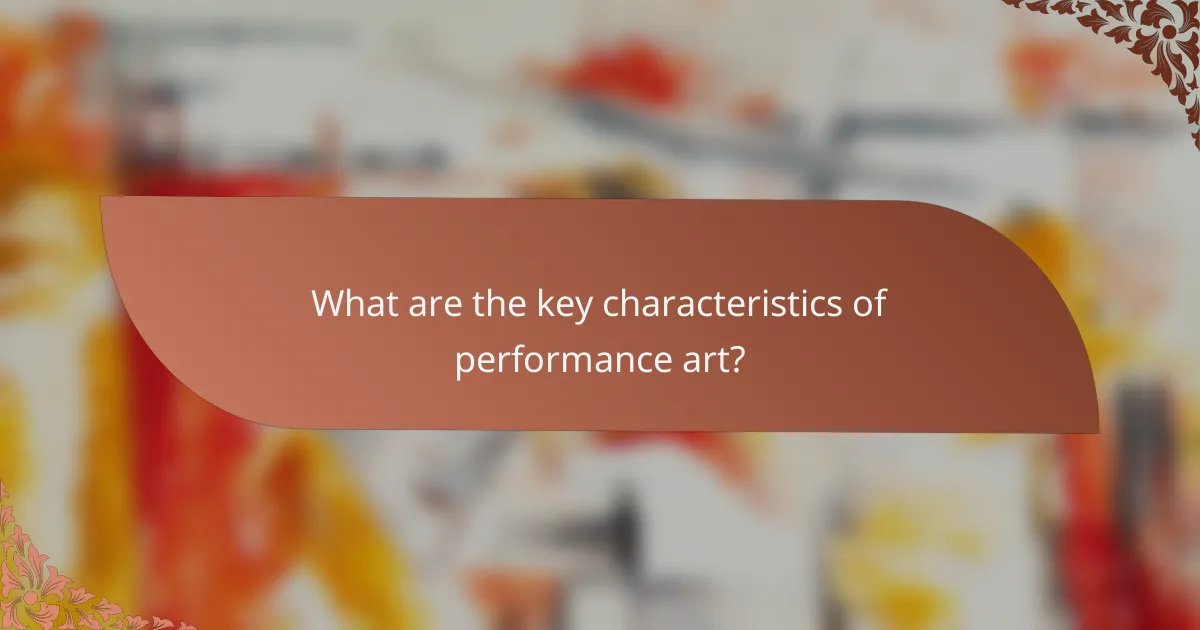
What are the key characteristics of performance art?
Performance art is characterized by its emphasis on live actions, audience engagement, and the integration of various art forms. Key characteristics include spontaneity, emotional expression, and the use of the body as a medium. Notable performers like Marina Abramović and Yoko Ono highlight the unique attributes of endurance and conceptual depth. Audience interaction often transforms spectators into participants, creating a shared experience that challenges traditional art boundaries.
How does performance art differ from traditional art forms?
Performance art differs from traditional art forms by emphasizing live action and audience engagement over static visual representation. Performance art is often spontaneous, allowing for real-time interaction and emotional responses. Notable performers like Marina Abramović and Yoko Ono have pushed boundaries, creating immersive experiences that challenge perceptions. In contrast, traditional art forms focus on finished works, such as paintings or sculptures, which do not involve the same level of audience participation.
What role does the body play in performance art?
The body plays a crucial role in performance art as it serves as the primary medium for expression and communication. Through movement, gesture, and physical presence, artists convey emotions, narratives, and concepts. The body’s capabilities, such as endurance and flexibility, enhance the impact of the performance. Unique attributes like the performer’s individual style and physicality can create distinct experiences for the audience. Audience interaction further amplifies the body’s role, transforming the performance into a shared experience that can evoke diverse interpretations and emotional responses.
How is time utilized in performance art?
Time in performance art is utilized as a dynamic medium that shapes the experience and meaning of the artwork. The duration of a performance can influence audience engagement and emotional response. Notable performers often manipulate time through pacing, repetition, and timing of actions to create tension or release. This interaction enhances the audience’s perception, making time an essential element in the overall impact of the performance.
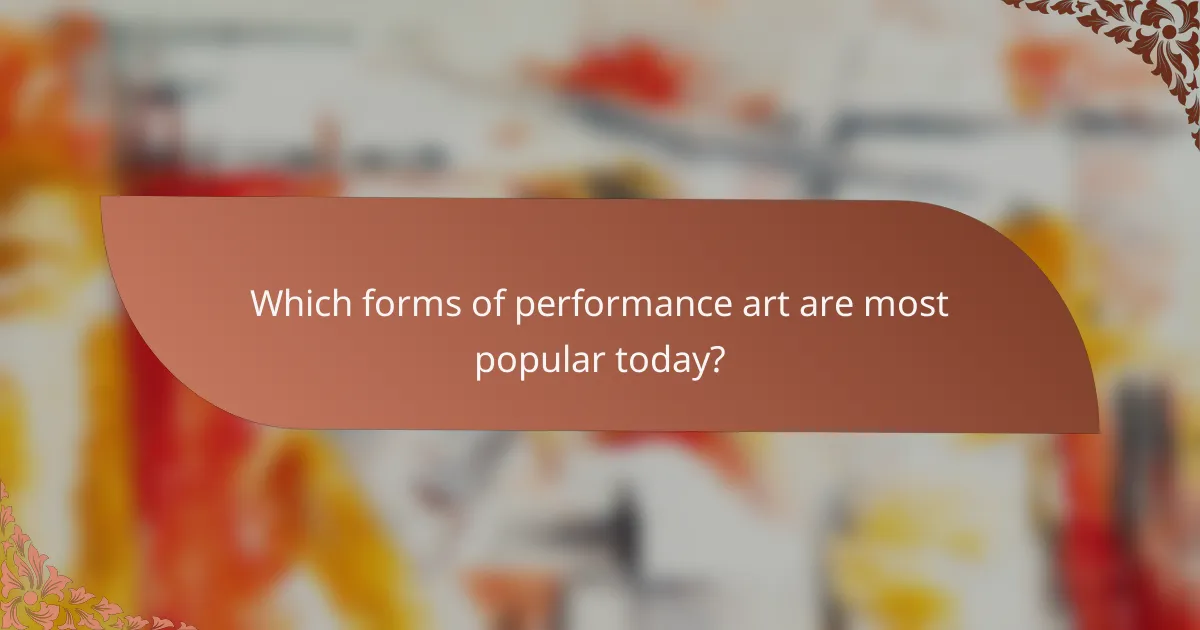
Which forms of performance art are most popular today?
Performance art today features diverse forms like theatre, dance, and multimedia installations. These genres engage audiences through interactive experiences. Notable performers include Marina Abramović and Bill T. Jones, who push boundaries and provoke thought. Emerging trends emphasize collaboration and technology integration, enhancing audience participation.
What are the defining features of immersive theatre?
Immersive theatre engages audiences through active participation and sensory involvement. Key features include audience interaction, non-linear narratives, and immersive environments. These elements create a unique experience that blurs the line between performers and spectators, fostering deeper emotional connections. Additionally, immersive theatre often utilizes unconventional spaces, enhancing the overall impact of the performance.
How has street performance evolved in urban settings?
Street performance in urban settings has evolved into a dynamic form of performance art that engages diverse audiences. Initially rooted in traditional street entertainment, it now incorporates contemporary elements such as multimedia and social commentary. Notable performers like Amanda Palmer and the Blue Man Group have pushed boundaries, using innovative techniques to captivate onlookers. Audience interaction has intensified, with performers often inviting participation, creating immersive experiences that blur the line between artist and spectator. This evolution reflects broader cultural shifts, emphasizing community engagement and artistic expression in public spaces.
What are the unique aspects of digital performance art?
Digital performance art uniquely blends technology and live artistry, creating immersive experiences. It often utilizes virtual reality, augmented reality, and interactive installations, allowing audiences to engage actively. This form transcends traditional boundaries, enabling real-time collaboration between performers and viewers. Unique aspects include the use of digital platforms for global reach and innovative expression, showcasing a fusion of visual art, music, and theatre.
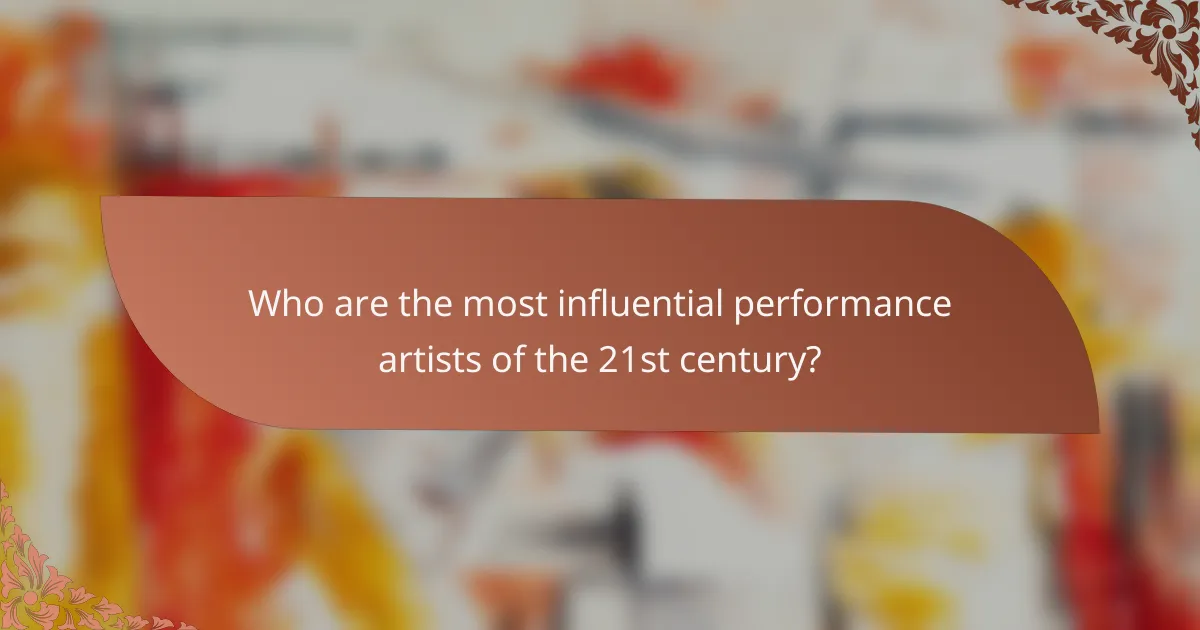
Who are the most influential performance artists of the 21st century?
The most influential performance artists of the 21st century include Marina Abramović, Ai Weiwei, and Yoko Ono. Marina Abramović is known for her endurance-based works that challenge the boundaries of art and audience interaction. Ai Weiwei combines art and activism, using performance to address social and political issues. Yoko Ono continues to engage audiences through participatory art, emphasizing peace and creativity. Their contributions have reshaped performance art, making it a vital medium for contemporary expression.
What impact has Marina Abramović had on the genre?
Marina Abramović has significantly influenced performance art by redefining audience interaction and emotional engagement. Her work emphasizes the relationship between performer and viewer, often blurring the lines between art and life. Abramović’s unique approach includes endurance-based performances, challenging physical and psychological limits. As a pioneer, she has inspired a new generation of artists to explore vulnerability and the transformative power of presence in performance art.
How did Yoko Ono shape the landscape of performance art?
Yoko Ono profoundly influenced performance art through her innovative concepts and audience engagement. She introduced the idea of art as an interactive experience, blurring the lines between performer and spectator. Her works, such as “Cut Piece,” challenged traditional art forms by inviting the audience to participate actively, creating a unique dialogue. Ono’s emphasis on peace and activism also shaped the thematic direction of performance art, inspiring future generations to use their art as a platform for social change. Her unique approach to collaboration and improvisation remains a hallmark of contemporary performance art.
What contributions have local artists made to the performance art scene?
Local artists have significantly enriched the performance art scene through innovative expressions and cultural narratives. They often incorporate local traditions, addressing social issues and fostering community engagement. Their unique perspectives challenge conventional norms, creating diverse experiences for audiences. Collaborative projects with other art forms further enhance the vibrancy and accessibility of performance art, making it a dynamic aspect of local culture.
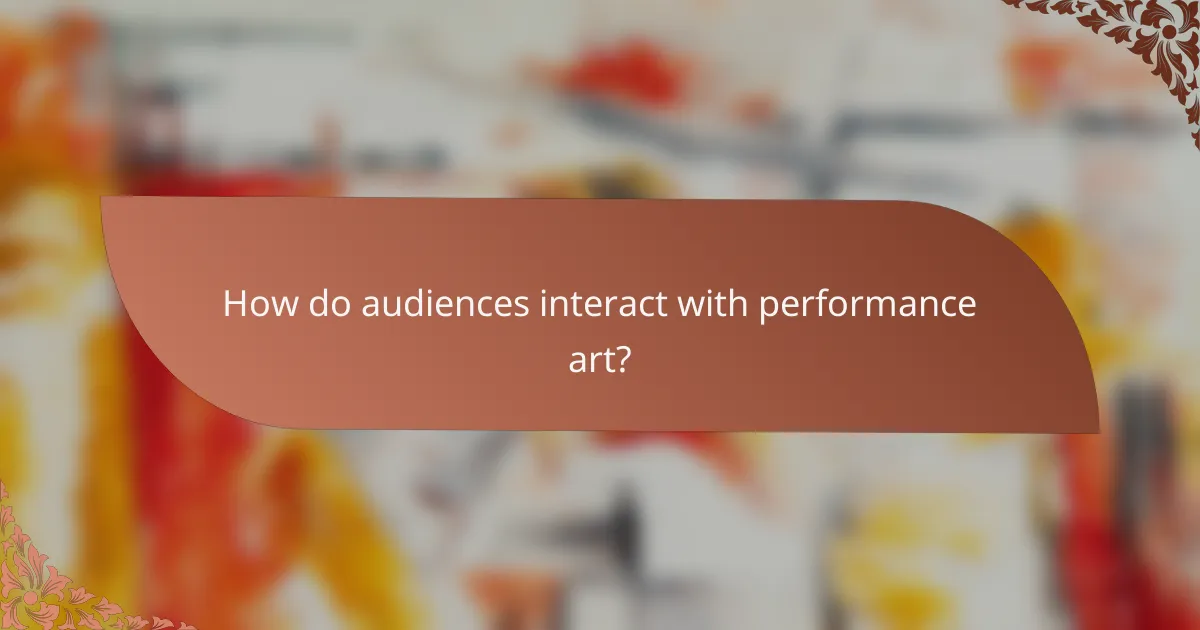
How do audiences interact with performance art?
Audiences interact with performance art through engagement, emotional response, and participation. This interaction enhances the overall experience and can vary widely based on the performance’s context and intent.
Notable performers often create immersive experiences that invite audience involvement. For example, Marina Abramović’s works challenge viewers to confront their own emotions and presence in the space.
Additionally, the unique attribute of performance art is its ephemeral nature, which requires immediate audience engagement. This fleeting quality can evoke strong reactions, prompting conversations and reflections long after the performance ends.
Moreover, audience interaction can manifest in various forms, such as feedback, physical participation, or even social media engagement. This dynamic relationship between performer and audience enriches the art form, making each performance a unique event.
What are the psychological effects of audience participation?
Audience participation in performance art can significantly enhance psychological engagement and emotional connection. It fosters a sense of community and shared experience among participants. Active involvement can lead to increased empathy and self-reflection, as individuals relate their personal experiences to the performance. Additionally, participation can reduce barriers between the performer and the audience, creating a more immersive environment. This dynamic interaction often results in heightened emotional responses and a lasting impact on the audience’s perception of the art form.
How does the setting influence audience engagement?
The setting significantly influences audience engagement by shaping the emotional and sensory experience. Performance art thrives in environments that enhance interaction, such as intimate spaces or public venues. For instance, a gallery setting can create a contemplative atmosphere, while a street performance invites spontaneity and community involvement. Unique attributes of the setting, such as acoustics and lighting, can amplify the impact of the performance, fostering deeper connections. Additionally, the cultural context of the venue may resonate with the audience, increasing their investment and engagement.
What are the challenges of audience interaction in performance art?
Audience interaction in performance art often faces challenges such as miscommunication, varying interpretations, and emotional responses. These hurdles can hinder the connection between performers and spectators. Additionally, the spontaneity of live performances may lead to unexpected reactions from the audience, complicating the intended message. Furthermore, cultural differences among audience members can impact their engagement and understanding of the performance.
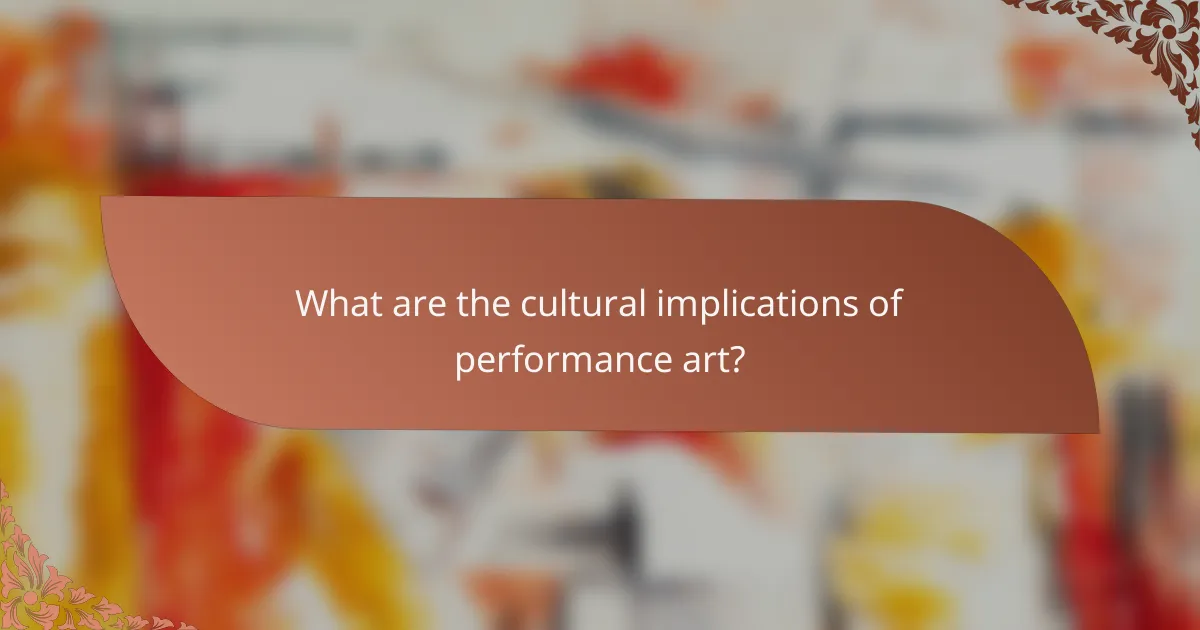
What are the cultural implications of performance art?
Performance art significantly influences culture by challenging societal norms and encouraging dialogue. It often reflects contemporary issues, pushing boundaries of expression and perception. Notable performers like Marina Abramović have utilized audience interaction to deepen emotional engagement, transforming spectators into participants. This interaction fosters community and shared experience, highlighting the unique attribute of performance art that distinguishes it from traditional art forms. As a result, performance art becomes a medium for cultural critique and social change.
How does performance art reflect societal issues?
Performance art reflects societal issues by addressing themes like identity, politics, and social justice. Through immersive experiences, artists engage audiences in critical dialogues about contemporary challenges. Notable performers like Marina Abramović and Ai Weiwei use their platforms to provoke thought and inspire change. This form of art often mirrors cultural tensions, making it a powerful medium for social commentary.
In what ways does performance art promote cultural exchange?
Performance art promotes cultural exchange by fostering dialogue, breaking language barriers, and encouraging collaboration. It invites diverse audiences to experience different cultural narratives and perspectives. Notable performers often incorporate traditional elements from their backgrounds, enhancing the authenticity of their work. As a result, performance art becomes a platform for shared experiences, promoting understanding and appreciation of various cultures.
What role does performance art play in activism?
Performance art plays a crucial role in activism by engaging audiences emotionally and provoking thought. It transforms social issues into visceral experiences, fostering awareness and dialogue. Notable performers like Marina Abramović and Ai Weiwei use their art to challenge political structures and human rights violations. This interaction creates a unique platform for marginalized voices, making complex issues accessible and relatable. Performance art’s ephemeral nature amplifies its impact, leaving lasting impressions that inspire action.
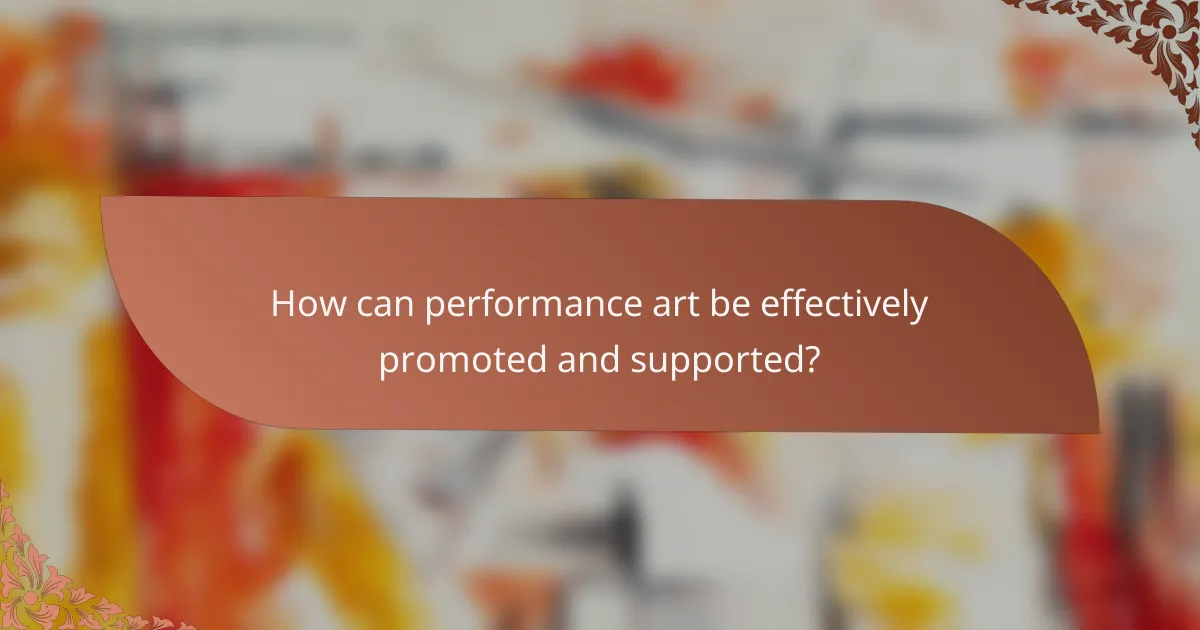
How can performance art be effectively promoted and supported?
Performance art can be effectively promoted and supported through community engagement, social media, and partnerships. Engaging local communities fosters a supportive audience base. Utilizing social media platforms increases visibility and attracts diverse viewers. Collaborating with local businesses and cultural organizations enhances resources and outreach. Notable performers often leverage these strategies to create impactful experiences.
What strategies can artists use to build an audience?
Artists can build an audience through engaging performance art strategies. They should focus on unique storytelling, interactive experiences, and leveraging social media platforms. Collaborating with other artists enhances visibility and fosters community. Hosting workshops or open rehearsals invites audience participation, creating a deeper connection. Utilizing diverse venues expands reach and attracts varied demographics.
How can community engagement enhance performance art initiatives?
Community engagement significantly enhances performance art initiatives by fostering collaboration and increasing audience investment. Engaged communities contribute diverse perspectives, enriching the artistic process. This interaction often leads to innovative performances that resonate more deeply with audiences, creating a shared experience. Furthermore, community involvement can expand outreach, attracting larger audiences and generating sustained interest in performance art. Engaging local stakeholders can also secure resources and venues, ensuring the longevity and success of initiatives.
What are the best practices for funding performance art projects?
To successfully fund performance art projects, focus on diverse funding sources and community engagement. Explore grants from arts foundations, crowd-funding platforms, and sponsorships from local businesses. Networking with other artists and organizations enhances visibility and support. Building a strong proposal that highlights the project’s unique attributes and potential audience impact is essential. Engaging audiences through pre-event promotions and interactive experiences can also attract funding and foster a loyal following.
What common mistakes should artists avoid in performance art?
Artists should avoid mistakes that detract from their performance art’s impact. Common pitfalls include neglecting audience engagement, failing to plan adequately, overcomplicating concepts, and ignoring emotional authenticity. These errors can diminish the overall experience and connection with the audience. Prioritizing clear communication and genuine expression enhances performance art’s effectiveness.
